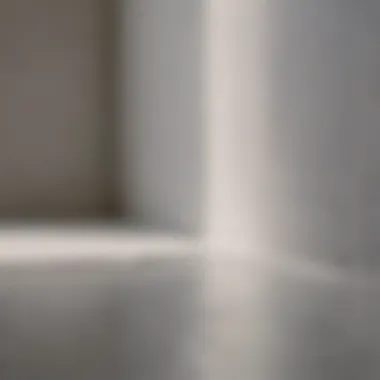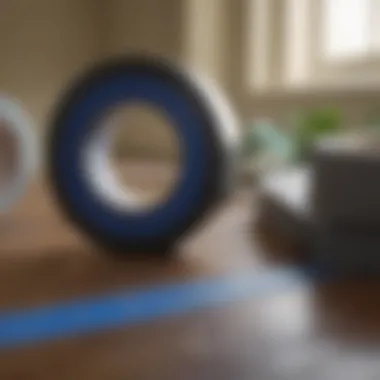Mastering the Art of Painters Tape Removal


Intro
Removing painters tape is often thought to be a simple task, but there are layers to it that can trip up even the most seasoned DIY enthusiasts. From streaky paint lines to the dreaded surface damage, various factors can influence the outcome of this seemingly straightforward job. By exploring some solid techniques and the science behind painters tape, this guide aims to address those common pitfalls and arm homeowners and paint aficionados with the knowledge necessary for success.
Understanding how to remove painters tape effectively can save hours of repainting work and can help preserve the integrity of the surfaces involved. It's about more than just yanking the tape off after the last coat dries. Timing, the type of tape used, and how you approach the peeling process all play an integral role in the final results.
Interior Design Tips
When embarking on a painting project, it’s beneficial to consider broader interior design implications that stem from tape removal practices. Here’s how to align your approach with good design principles:
- Clean Edges: Achieving clean edges is critical. Think about how crisp lines enhance the overall look of a space. A careful tape removal process will bolster your interior aesthetic.
- Color Schemes: Certain color schemes can heighten the effects of your paint work. For a vibrant accent wall, using painters tape protects adjacent colors and textures. Ensure that you remove the tape when the paint is still slightly tacky to reduce peeling.
- Furniture Arrangement: Plan your furniture arrangement to highlight freshly painted areas. Tape removal can stir up dust. If possible, ensure protective coverings are in place for your newly painted surfaces before moving any furniture back.
Timing Strategies
Timing is paramount when it comes to tape removal. Here are a few pointers to guide you:
- Remove After 30-60 Minutes: For most paints, allow it to set for half an hour to an hour before taking off the tape. This timing helps to ensure that the paint bonds well without being too dry to peel the tape effectively.
- Latex vs. Oil Paints: Knowing the type of paint you've used can dictate the timing. Latex paints generally stick less, so removing the tape while the paint is still slightly wet often yields better results.
"The real trick is to not rush this step. Patience often pays off, and it'll show in the precision of your paint lines."
Surface Preparation
Adequate surface preparation can't be emphasized enough. Here are strategies to prepare surfaces, reducing the likelihood of unwanted damage during tape removal:
- Clean the Surface: Dust and debris can cling to painters tape, causing poor adhesion. Ensure surfaces are cleaned beforehand.
- Test on a Small Area: For new or delicate surfaces, test your tape and paint application on an inconspicuous area first. This can help identify any potential issues with adhesion or removal.
- Use Quality Tapes: Investing in higher quality painters tape can significantly improve your overall experience. Some tapes are designed specifically for easy removal without leaving residue, ideal for delicate surfaces.
By integrating these elements and mindful practices into your project, you'll gain substantial control over the painting process, leading to exceptional finish results.
Understanding painters tape thoroughly transforms a generally tedious job into a precise and rewarding task.
Understanding Painters Tape
Before diving into the nitty-gritty of removing painters tape, it’s vital to grasp what painters tape actually is and why it matters in the world of painting. Understanding painters tape can help you avoid common pitfalls, enhance your project’s outcome, and save time and resources. A successful painting job relies not just on the quality of paint and technique, but also on the tools involved. Painters tape is one such tool that ensures clean, crisp lines, elevating the overall finish of your work.
Definition and Purpose
Painters tape, also known as masking tape, is a specially designed adhesive tape that helps create clean edges in painting projects. Its primary purpose is to protect surfaces from paint splatter while providing a sharp line for a professional appearance. Unlike regular tape, painters tape features a low-tack adhesive that removes easily without damaging the underlying surface. This characteristic makes it particularly valuable to those who value precision in their work.
Types of Painters Tape
Painters tape comes in various types, each catering to specific applications and surface requirements.
Masking Tape
Masking tape is the most basic form of painters tape. This type is a versatile choice, well-suited for lightweight tasks. What makes it stand out is its ease of use; it sticks well but can be removed quickly without leaving too much residue behind. The key characteristic of masking tape is its affordability, which makes it a go-to for budget-minded DIY enthusiasts. However, it falls short when it comes to sharp paint lines, especially on textured surfaces.
Blue Tape
Blue tape is probably the most recognized type in the painters' community. It is specifically formulated for sensitive surfaces and for accomplishing crisp lines. The unique feature of blue tape is its ability to stick without damaging your walls or leaving a mess upon removal. Many opt for blue tape because it’s designed with a special backing that lays flat, reducing the risk of paint seeping underneath. The downside? It tends to be pricier than basic masking tape.
Green Tape
Green tape is similar to blue tape but typically has a slightly stronger adhesive. It’s often favored by professionals due to its high-performance characteristics. This tape can adhere to a wider range of surfaces, including stucco and concrete, making it suitable for various projects. A notable advantage of green tape is its UV resistance, which allows it to perform well in outdoor applications. Nevertheless, it may not be the best option for delicate surfaces, as removal can sometimes lead to damage.
Choosing the Right Tape for Your Project
Deciding on the appropriate type of painters tape for your project can make all the difference. Factors like the painted surface, the type of paint being used, and even weather conditions should be taken into account. A mishap in tape choice could lead to messy lines, which defeats the purpose of applying the tape in the first place. Therefore, understanding the tapes available and their characteristics propels you towards a more successful painting outcome. Briefly, when selecting tape, consider:
- Surface type (smooth vs. textured)
- Duration being adhered (short-term vs. long-term)
- Temperature conditions (indoor vs. outdoor)
"The right tape can elevate your painting project from amateur to professional. Make your choice wisely."


Understanding painters tape is not just trivial knowledge; it’s integral to achieving that polished finish that turns heads. Knowing the strengths and weaknesses of various types of tape facilitates better decision-making, resulting in well-executed painting projects.
Preparing for Removal
When it comes to getting painters tape off, paying attention before you even start pulling can make all the difference. This stage is like the groundwork before any big construction work. It's not just about taking it off; it’s about doing it right to avoid those cringe-worthy moments of ruined paint lines or damage to your surfaces.
Before diving into the nitty-gritty of removal techniques, you must evaluate a few essential elements. Doing this preparation right can save headaches later, and it can mean the difference between a smooth finish and a botched job. Ultimately, considering timing, surface type, and having the right tools will take you a long way in achieving that clean, sharp look everyone strives for.
Timing Your Removal
Immediate Removal After Painting
Talking about taking the tape off right away can be a game changer. Immediate removal is often touted as the best choice for achieving the cleanest lines. This method relies on the fact that when the paint is still wet or tacky, the tape can peel away more easily without pulling up any dried paint with it. Here’s the kicker: there’s no chance for paint to dry and bond too tightly to the tape, which can lead to peeling issues later on.
However, it’s essential to be cautious—if you remove it too soon, you risk smearing wet paint. A delicate balance is needed here. Generally, waiting for the paint to be set for about an hour is advisable, so you still catch it in a sweet spot. It's one of those techniques where, if done well, will keep your project looking sharp and professional.
Waiting Period Considerations
On the other hand, waiting a bit longer can also be a viable option. Some folks might argue that patience pays off, particularly with specific paint types that need more time to cure. If you've used oil-based paints, letting it sit for a few hours before removal could help ensure a clean peel.
The major advantage here is that you allow the paint itself to harden fully, reducing any risk of smudging or smearing. Yet, be warned: wait too long, and you might find yourself tugging at stubbornly adhered tape that could take chunks of paint along for the ride. Ultimately, it all comes down to a check on surface condition and paint type.
Assessing Surface Type
Textured Surfaces
Now, let’s shift gears and focus on surface types because they dramatically affect how tape interacts during removal. Textured surfaces can be a bit tricky. Those grooves and ridges that give walls character can also make it harder for tape to form a solid bond. This can lead to paint spills creeping underneath the tape, especially if the surface isn't completely clean before taping it.
Using a slightly stiffer adhesive might help here, but remember—you run the risk of tearing if you don’t remove it at the right moment. Knowing your surface type ensures that you prepare adequately, leading to more favorable outcomes.
Smooth Surfaces
In contrast, when dealing with smooth surfaces, the situation seems a tad more manageable. Paint adheres well, and tape sticks firmly, which is often a favorable combination for clean lines. Here, the removal process can be easier. Just be alert—let the paint dry completely and this will minimize risks of mucking up the beautifully painted edges.
Considerations around the type of paint again come into play here—if you've just applied a gloss finish, you definitely want to stick to the proper timing.
Tools and Materials Needed
Utility Knife
Let’s chat about tools. A utility knife isn’t something you think about much, but it sure can be your best friend during removal. A sharp blade allows you to score the tape edge carefully, making it easier to pull off without disrupting the underlying paint. Just remember to be gentle and precise—the goal is to minimize any damage to your work. Plus, using a knife can give you that added control when dealing with tricky corners or stubborn areas.
Adhesive Remover
Sometimes paint tape removal isn’t as simple as just pulling it. This is where an adhesive remover comes into play. This can be a lifesaver for those nagging bits of residue that won’t budge. Selecting a good quality product can make your life easier. Look for something that breaks down the adhesive without damaging the surface underneath. However, always test a small area first. Getting rid of tape-related gunk can be messy if not done correctly.
Soft Cloth
Lastly, a soft cloth can be more useful than you assume. Once you've removed the tape, use a soft cloth to wipe down the surface and pick up any lingering bits of adhesive. This ensures that your project not only looks great but feels smooth to the touch. It’s a simple touch that wraps everything up nicely.
Preparing for removal is not just about getting the tape off—it's about understanding the nuances that come with it. The right timing, surface evaluation, and essential tools can greatly enhance the overall outcome, ensuring that every painting endeavor ends with the desired clean, crisp finish.
Techniques for Effective Removal
Understanding the right techniques to remove painters tape is crucial for maintaining the quality and aesthetics of your newly painted surfaces. Improper removal can lead to jagged edges and may even peel away the paint underneath. Different methods can yield varying degrees of success, depending on factors such as the type of tape used and the surface it’s applied to. Mastering the strategies discussed below can ensure clean, sharp lines, preserving the look you worked hard to achieve.
Peeling Method
This is perhaps the most widely recognized technique. But don’t be fooled by its simplicity; the peeling method is all about finesse.
Pulling at an Angle
Pulling at an angle is a key aspect of this technique. By gently pulling the tape back at a 45-degree angle, you reduce the chance of lifting the paint along with the tape. This way, you maintain a crisp edge where the paint meets the surface.


One of the standout characteristics of this approach is its ease of implementation. Homeowners can simply slide their fingers under the tape’s edge and pull it back steadily without requiring tools. While this method is generally effective, the unique challenge arises with textured surfaces, where extra caution is necessary to avoid lifting paint. Always remember to be patient—speed can lead to mistakes.
Maintaining Steady Tension
Equally as important is the concept of maintaining steady tension while pulling. This technique involves applying consistent pressure as you peel away the tape. It prevents the tape from snapping back and causing any unintentional damage to your freshly painted lines.
The attractive feature of this strategy is its straightforward nature. The good news is that it requires no specialized tools, just some careful movement on your part. However, finding that balance in tension can be tricky; too much tension might tear the tape, and too little can cause the paint to lift. It takes practice, but it’s well worth the effort.
Using Heat to Loosen Adhesive
Employing heat can be a game-changer when dealing with stubborn adhesives. This method can soften the bond between the tape and the surface.
Heat Gun Techniques
Using a heat gun represents a more advanced approach to tape removal. By directing gentle heat along the tape, you can effectively loosen the adhesive. This not only facilitates an easier peeling process but also helps to diminish the likelihood of residue or damage.
The key characteristic of this technique is its effectiveness on long-standing or highly adhesive tapes, especially those that’ve been sitting a while. However, this method isn’t without its pitfalls. Overheating can cause warping or bubbling on delicate surfaces, so it requires a practiced hand to execute successfully.
Caution with Heat Application
While heat can be beneficial, it also calls for caution. Not all surfaces withstand heat well, and you risk damaging the paint or the underlying material if you're not careful.
This careful application is crucial, as it allows you to take full advantage of the heat method without compromising your hard work. Always keep the heat source at a safe distance and test on inconspicuous areas first to gauge the response of the material.
Incorporating Solvents
For sticky situations, solvents can be your best friend. When all else fails, these substances can help dissolve stubborn adhesive residues left behind.
Recommended Solvents
Among the most effective solvents are adhesive removers or isopropyl alcohol. These products can work wonders on tough adhesive remains. They effectively break down the bond between the tape and the painted surface, allowing for easier removal.
The unique feature of using solvents is their ability to tackle varied adhesive types. Whether it’s a traditional masking tape or more specialized varieties, there’s likely a solvent tailored to effectively handle it. That being said, it’s vital to choose a solvent that’s compatible with your surface to avoid any unwanted damage.
Application Methods
Using solvents typically involves applying them with a soft cloth or sponge directly onto the residue. This method allows the solvent to penetrate the adhesive, breaking it down quickly without excessive manual scrubbing.
The simplicity of this application method makes it an alluring choice for many. However, keep in mind that while solvents can dissolve adhesive, they can also alter certain finishes or paints. Always perform a spot test in a discreet area beforehand.
Remember, the removal of painters tape is not a one-size-fits-all process; recognizing the right techniques and employing them effectively can make a world of difference.
Common Challenges and Solutions
Removing painters tape can be a bit of a double-edged sword. While it serves as a handy ally in achieving sharp paint lines, it can throw some curveballs when it’s time to peel it away. Understanding these common challenges and preparing solutions can significantly enhance your painting experience. This section dives into problems like adhesive residue and surface damage, providing insights and strategies to tackle them effectively.
Adhesive Residue Issues
Identifying Residue Types
Recognizing the types of adhesive residue left behind is crucial in addressing this common issue. Often, it’s just a matter of looking closely at the surface. There are basically two main culprits: oil-based residues and water-based ones.
- Oil-based residues are typically more stubborn and can linger after tape removal, requiring more aggressive methods.
- Water-based residues, on the other hand, are often sticky and may be cleaned more easily with warm soapy water.
Differentiating between these types helps determine your removal strategy. Knowing the nature of the residue keeps you from doubling down on ineffective removal methods.
Effective Removal Strategies
When it comes to dealing with adhesive residues, having a game plan is essential. Rather than going in guns blazing, consider these strategies:
- Use of solvents: Products like rubbing alcohol or commercial adhesive removers can work wonders in loosening sticky residues. Always perform a patch test first to avoid any unwelcome surprises on the surface.
- Rubbing Mechanism: Sometimes, simple friction with a soft cloth can effectively lift residues with minimal fuss. Remember, patience is a virtue here; you don't want to scrub too hard and inadvertently harm the surface.
Each of these strategies has its own merits. The solvent method can be highly effective but may require more effort to ensure surface compatibility. On the flip side, a gentle rub can be low-risk but take longer to achieve results.


Surface Damage Concerns
Preventing Surface Damage
Avoiding surface damage is key when you're removing tape. One worthwhile tactic is to ensure that your surfaces are primed appropriately before painting. This prep step can make a world of difference. Additionally, you should be mindful of the removal technique you employ.
- Slow and steady: Always pull the tape back at a low angle. Trying to yank it off quickly can lead to tearing or peeling away bits of the paint underneath.
- Timing: Remember to follow the recommended time frames for tape removal outlined in previous sections. Waiting too long or removing it just too soon can both lead to damage.
Utilizing prevention techniques can save you heartache down the line. Just remember, a careful approach is worth its weight in gold when it comes to protecting your hard work.
Repairing Existing Damage
Sometimes, despite our best efforts, damage might occur. In such cases, it’s crucial to have a plan for repairs. Identifying the type and extent of the damage is the first step. Then, consider these options:
- Touch-up Paint: If it’s minor, touching up the paint can be the simplest solution. This method allows you to fix only what's necessary without a full re-paint.
- Surface Repair Products: For more severe cases, using filler or wood putty for dings or scrapes may be needed. Just make sure to sand and paint over to achieve a seamless appearance.
Repair strategies hinge on accurate damage assessments. Utilizing the right products means you can maintain the integrity of your painting project without losing time or money.
Overall, while the challenges of residue and surface damage might seem daunting, they’re certainly not insurmountable. Adapting the right methods to enhance your tape removal process will lead to the perfect finish for your project.
Long-Term Considerations
Removing painters tape isn't just a one-and-done task. If you want long-lasting results in your painting projects, there are factors to keep in mind that can enhance your experience. This section digs into those important elements that goes beyond the immediate step of pulling off the tape.
One crucial aspect is how to store the tape when you’re not using it. Painters tape needs to be kept in conditions that preserve its adhesive properties and shape. When it's stored properly, it can be just as effective in the future as it was during your last project.
Storage and Application Tips
Storing Painters Tape
Storing painters tape correctly is essential for maintaining its effectiveness. The ideal way to store it would be in a cool, dry place, away from direct sunlight and moisture. Keeping tape in a sealed container can also help safeguard it from dust and debris, which can disrupt its adhesive.
Key characteristics of proper storage include:
- Temperature Control: Fluctuations in temperature can weaken the adhesive.
- Protection from Elements: Humidity and UV light can degrade tape, making it less effective when needed.
These factors make sure the tape remains sticky and pliable, maximizing its benefits when it’s time to apply it again.
Best Practices for Application
When it comes to applying painters tape, a few best practices can help achieve the clean lines and finishes you desire. Using a firm hand to press down the edges helps create a seal that minimizes paint bleed.
Several points to consider for effective application:
- Surface Preparation: Clean surfaces beforehand ensures that the tape adheres well.
- Smoothing Technique: Use a straight edge or a putty knife to smooth down the tape after application.
By following these best practices, painters can avoid pitfalls like paint seeping under the tape, which compromises the entire project. It's all about precision and little tricks that yield significant results.
Evaluating Tape Performance
Testing Different Brands
Not all painters tape is created equal. Testing various brands can reveal differences in performance that can affect outcomes in painting projects. Some tapes offer better adhesive qualities, while others may come off easily, leaving no residue.
This testing can be crucial for ensuring that you choose the right tape for your unique needs. You wouldn’t want a brand that is known to rip or leave behind gunk on surfaces you worked hard to prepare. Keeping a note of what worked and what didn’t can save headaches down the road.
Understanding New Developments
The market for painters tape continually evolves, with manufacturers regularly introducing new formulations and materials. Staying updated on these developments can be beneficial in selecting efficient products that might work better than older versions.
Key characteristics of these new developments include:
- Improved Adhesives: These can offer stronger hold without damaging the surface.
- Eco-Friendly Options: These avoid leaving harmful residues, attracting environmentally conscious homeowners.
Knowing what’s new and improved allows for more informed choices, ensuring your future projects are smooth sailing.
"Long-term planning in selecting and storing your painters tape can lead to shave time and effort from future projects."
By paying attention to these details, you not only make each project easier but set yourself up for greater success overall.







